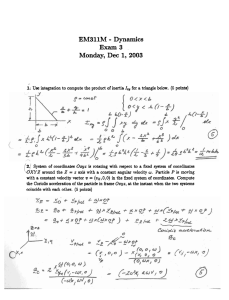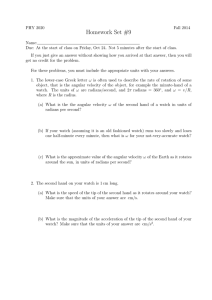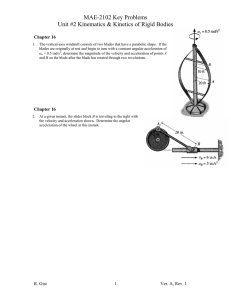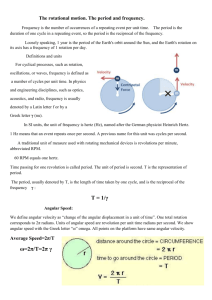Angular Kinematics
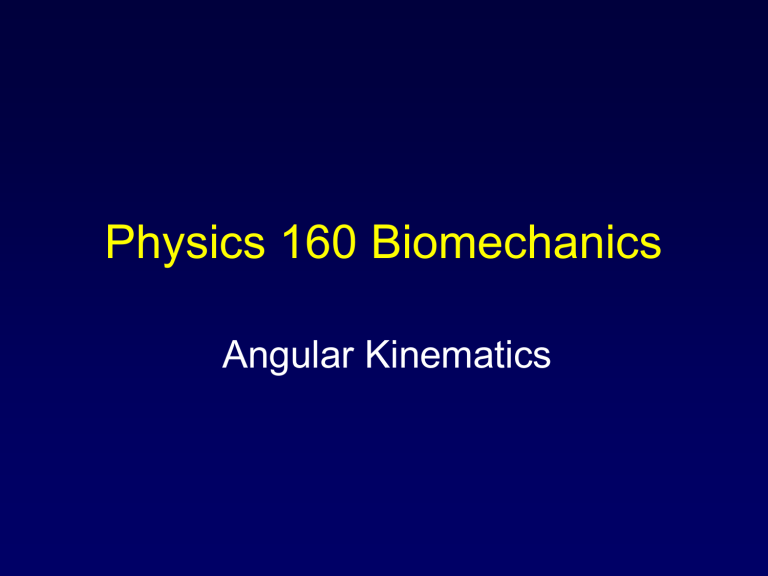
Physics 160 Biomechanics
Angular Kinematics
Questions to think about
• Why do batters slide their hands up the handle of the bat to lay down a bunt but not to drive the ball?
• Why might an athletic trainer or physical therapist want to measure the range of motion of a joint?
Angular Kinematics
• Angular motion: all parts of a body move through the same angle
• Angular kinematics deals with angular motion.
• Nearly all human movement involves rotation of body segments.
Qualitative Application of
Biomechanical Principle
– EX. Soccer kick
Hips (flexion,rotation) --> knee (extension)
Qualitative Application of
Biomechanical Principle
– EX. Soccer kick
Hips (flexion,rotation) --> knee (extension)
Qualitative Application of
Biomechanical Principle
– EX. Soccer kick
Hips (flexion,rotation) --> knee (extension)
Qualitative Application of
Biomechanical Principle
– EX. Soccer kick
Hips (flexion,rotation) --> knee (extension)
Qualitative Application of
Biomechanical Principle
– EX. Soccer kick
Hips (flexion,rotation) --> knee (extension)
Qualitative Application of
Biomechanical Principle
– EX. Soccer kick
Hips (flexion,rotation) --> knee (extension)
Qualitative Application of
Biomechanical Principle
– EX. Soccer kick
Hips (flexion,rotation) --> knee (extension)
Qualitative Application of
Biomechanical Principle
– EX. Soccer kick
Hips (flexion,rotation) --> knee (extension)
Qualitative Application of
Biomechanical Principle
– EX. Soccer kick
Hips (flexion,rotation) --> knee (extension)
Qualitative Application of
Biomechanical Principle
– EX. Soccer kick
Hips (flexion,rotation) --> knee (extension)
Qualitative Application of
Biomechanical Principle
– EX. Soccer kick
Hips (flexion,rotation) --> knee (extension)
Qualitative Application of
Biomechanical Principle
– EX. Soccer kick
Hips (flexion,rotation) --> knee (extension)
Qualitative Application of
Biomechanical Principle
– EX. Soccer kick
Hips (flexion,rotation) --> knee (extension)
Qualitative Application of
Biomechanical Principle
- EX. Soccer kick
Hips (flexion,rotation) --> knee (extension)
Qualitative Application of
Biomechanical Principle
– EX. Soccer kick
Hips (flexion,rotation) --> knee (extension)
Rotational Motion
General Motion Rotation and
Translation
Instantaneous Center of Rotation
The instantaneous joint center changes throughout any motion of the knee.
Measuring Angles
• An angle is at the intersection of two lines (and planes).
• Units of measurement
– Degrees (arbitrary units)
– Radians (fundamental ratio)
– Revolutions (one revolution =
360 o )
• Circumference = 2
π r; therefore, there are 2
π
radians in 360 o
Angular Kinematic Quantities
Units of angular measure
90 degrees
π
2 radians
1
revolution
180 degrees
π radians
1
revolution
270 degrees
3
π
2 radians
3
revolution
360 degrees
2
π
radians
1revolution
Radians
• One radian is the angle at the center of a circle described by an arc equal to the length of the radius.
Converting Angles
• 1 radian = 57.3
o
• 1 revolution = 360 o = 2
π radians
θ
(deg)
= π θ
( rad )
• Examples:
– Convert 30 o to radians.
– Convert 4 radians to degrees.
Relative versus Absolute Angles
Relative angle: the angle formed between two adjacent body segments (on right)
Absolute angle: angular orientation of a single body segment with respect to a fixed line of reference (on left)
Absolute Angles
Definition of the sagittal view absolute angles of the trunk, thigh, leg, and foot.
Rear Foot Angles
Definition of the absolute angles of the leg and calcaneus in the frontal plane. These angles are used to constitute the rearfoot angle of the right foot.
Standard Reference
Terminology
• Movements
– Angular - Circular movements around an axis of rotation . Unit of reference --> angle (degrees or radians).
• Rotation -turning of a bicycle wheel or limb segments around joints
• Axis of rotation
>middle of circle
>center of joint
Def: imaginary line about which rotation occurs (pivot, hinge)
origin
Circular Reference Terms
• Circumference (C=2
πr)
• Radius (r) – the distance from the axis of rotation to the perimeter of the circle
• Diameter (D) – the distance between one side of a circle to the opposite going through the axis of rotation
• Arc – A rotary distance between 2 angular positions
• Arclength – curvilinear distance covered on the perimeter of an arc
• pi (
π
) = 3.14159…….
Angular Velocity
• Angular velocity is the rate of change of angular displacement
ω = change in angular position change in time
ω =
ω =
∆ θ =
θ f
− θ i t f
− t i
=
∆ = time in [ ]
∆ θ
∆ t
[ / s ]
]
Example
A therapist examines the range of motion of an athlete’s knee joint. At full extension, the angle between the leg and thigh is 178 o . At full flexion, the angle between the leg and thigh is
82 o . The leg is moved between these two angles in 1.2 s.
What is the angular velocity of the leg?
Example
Figure skater Michelle Kwan performs a triple twisting jump.
She rotates around her longitudinal axis three times while she is in the air. The time it takes to complete the jump from takeoff to landing is 0.8 s. What was
Michelle’s average angular velocity in twisting for this jump?
Angular Acceleration
• Angular acceleration is the rate of change of angular velocity.
α
α
=
= change in angular velocity change in time
ω f
− ω i t f
− t i
=
∆ ω
∆ t
α = angular accleration in rad s
2
[ / ]
[ / ]
∆ =
[ ]
Example
When Josh begins his discus throwing motion, he spins with an angular velocity of 5 rad/s. Just before he releases the discus, Josh’s angular velocity is 25 rad/s. If the time from the beginning of the throw to just before release is 1 s, what is
Josh’s average angular acceleration?
Example
• Randy Johnson is pitching a fastball at a speed of 103 mph. At
0.2 sec into his throw, the angular velocity of the left elbow is
260 °/sec. Two frames later, his elbow is extending at
1310°/sec. If the film speed is 30 frames/sec, what is the angular acceleration of the elbow joint?
Example
Randy Johnson is pitching a fastball at a speed of
103 mph. At 0.2 sec into his throw, the angular velocity of the left elbow is 260 °/sec. Two frames later, his elbow is extending at 1310°/sec. If the film speed is 30 frames/sec, what is the angular acceleration of the elbow joint?
A
ω
2
ω
1
Example
A golf club is swung with an average angular acceleration of
1.5 rad/s 2 . What is the angular velocity of the club when it strikes the ball at the end of a
0.8 s swing?
Linear and Angular Displacement
s
= linear dis tan ce
= × s r
θ
(
∆ θ must be in radians )
Example
If the arm segment has length 0.13 m and it rotates about the elbow an angular displacement of 0.23 radians, what is the linear distance traveled by the wrist?
Linear and Angular Velocity
v
= linear velocity
= × v r
ω
( / )
= ×
/ )
Example
Two baseballs are consecutively hit by a bat. The first ball is hit 25 cm from the bat’s axis of rotation, and the second ball is hit 45 cm from the bat’s axis of rotation. If the angular velocity of the bat was 35 rad/s at the instant that both balls were contacted, what was the linear velocity of the bat at the two contact points?
Example
A tennis racket swung with an angular velocity of 12 rad/s strikes a motionless ball at a distance of 0.5 m from the axis of rotation. What is the linear velocity of the racket at the point of contact with the ball?
Linear and Angular Acceleration
a
= linear acceleration
= × a r
α m s
2 = m
× rad s
2
( / ) ( ) ( / )
Radial Acceleration
Since linear velocity is a vector its direction will change even if the angular speed of an object is constant. The acceleration associated with the changing direction of the velocity vector is called radial acceleration or centripetal acceleration.
( linear velocity )
2 a r
= radial acceleration
= radius of rotation a r
= v
2 r m s
2
( / )
=
( / )
2 m
Tangential and Centripetal Acceleration
linear acceleration=tangential acceleration=a
T radial acceleration=centripetal acceleration=a
C
Example
An individual is running around a turn with an 11 m radius at 3.75 m/s. What is the runner’s centripetal acceleration?
Example
A hammer thrower spins with an angular velocity of 1700 o /s. The distance from her axis of rotation to the hammer head is 1.2 m. a) What is the linear velocity of the hammer head? b) What is the centripetal acceleration of the hammer head? c) If the distance to the hammer head changes to 1.0 m does the centripetal acceleration increase or decrease?

